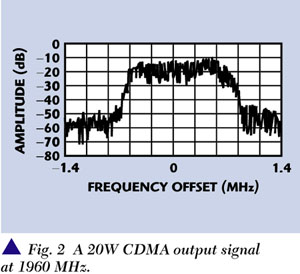A Versatile Multilevel Amplifier for PCS Applications
AML Communications Inc.
Camarillo, CA
 Communication amplifier designers today are challenged with rapidly bringing to market a qualified product in a mature form factor, while meeting strict spectral regrowth requirements. Combine this with varying power level and gain requirements from various system designers, differing operational voltages and unique interface protocols, and the result is the necessity of rapidly creating unique solutions in a minimal time frame.
Communication amplifier designers today are challenged with rapidly bringing to market a qualified product in a mature form factor, while meeting strict spectral regrowth requirements. Combine this with varying power level and gain requirements from various system designers, differing operational voltages and unique interface protocols, and the result is the necessity of rapidly creating unique solutions in a minimal time frame.
In answer to these challenges a platform solution has been developed that supports these needs. The Alpaca amplifier platform is a multilevel implementation with separate mechanical sections that incorporate an RF pallet, a DC distribution pallet and a microcontroller I/O pallet. The concept supports a mix and match modular approach where rapid development can be concentrated on a specific part of the platform. For example, a system designer may have a specific interface and DC supply voltage that he or she wishes to use for multiple formats and frequency bands. The controller and DC distribution pallets remain common to all of this designer's implementations. The RF design pallet is specifically designed for each application with respect to gain, power and format. This configuration provides a common mechanical, DC power and digital interface to the system for multiple requirements, and reduces cost by permitting higher volume manufacture of the common elements of the amplifier. Alternatively, an existing RF pallet can be configured to interface with an alternate user's digital interface by integrating a new microcontroller I/O pallet.
The displayed amplifier shown is an 80 W IS-136 compliant PCS single carrier amplifier operating from a wide range 20 to 30 V DC supply. It offers extended operational temperature range to 100°C with a wide range of user set autonomous action thresholds as well as providing digital information back to the host system regarding operational voltage levels, transmit power, input power and reflected power. Spectral regrowth performance is shown in Figure 1 .

Performance specifications for this particular amplifier include a 1930 to 1990 MHz frequency range and p/4 differential quadrature phase shift keying modulation required for TDMA operation. The RF output power for full compliance is +49 dBm (min) and the output power dynamic range is 15 dB (min). Input power is 17.5 to +1.0 dBm with a nominal gain (set point) of 50.0 ±0.6 dB. The amplifier's gain is extremely stable, exhibiting variations of ±0.6 dB in each case for effects of temperature, frequency, dynamic output power and DC input variations.
The amplifier's broadband noise suppression for the adjacent channel (±30 kHz), alternate channel (±60 kHz) and second alternate channel (±90 kHz) is 27, 46 and 57 dBc (max), respectively. Modulation accuracy is 3.5 percent RMS error vector magnitude (max). Group delay variation is 2 ±2 ns (max). Forward on/off isolation and reverse isolation is 50 dBc (min), and the amplifier's input and output impedance is 50 O with an SWR or 1.5 (max). The amplifier's nominal input current draw is 14.8 A at 80 W. DC input to RF output power efficiency is 20 percent (min) with an input power of 400 W (max). DC input power in the off state is 15 W (max).
These specifications reflect the requirements for an amplifier whose application is in the TransCell™ 1900 TM Highway Corridor TDMA wireless system produced by Trancepts Inc. As mentioned, modifying one of the three pallets can change the amplifier's application. Figure 2 shows performance of the product configured for a 20 W-CDMA application.

CONCLUSION
A versatile multilevel amplifier has been developed that incorporates three distinct pallets comprised of the RF, DC and microcontroller I/O sections. Each pallet can be specifically tailored to a particular application while taking advantage of common manufacturing of the other two sections. Additional information may be obtained via e-mail at sales@amlj.com.
AML Communications Inc.,
Camarillo, CA (805) 388-1345.
